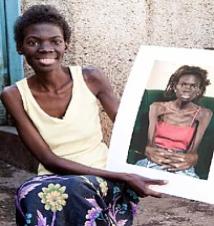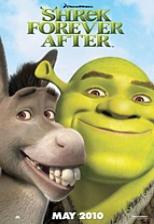
A heart wrenching mini doc, a supreme example of movie junk food
film from a queer perspective
Reviews
| KATM media outlets |
| KATM featured weekly |
| Join Us! |
| KATM on RT |
| Vidcast Starring KATM |
| NOTE: THIS SITE ONLY LOADS CORRECTLY WITH EXPLORER AND MOZILLA BROWSERS - SORRY SAFARI USERS! |
| Buy the KATM Book |
Different as Night and Day:
The Lazarus Effect-Shrek Forever After
Expanded Edition of 5-19-10 WCT Knight at the Movies column
By Richard Knight, Jr.
The Lazarus Effect-Shrek Forever After
Expanded Edition of 5-19-10 WCT Knight at the Movies column
By Richard Knight, Jr.
| The statistics are not just sobering – they’re horrifying: though preventable, over 20 million people have died in Africa from AIDS. How many could have been saved if ARVs (antiretroviral drugs) had arrived before 2003 when a group of concerned global health organizations (including Bono’s “RED” campaign) stepped in and got the drugs to those desperately in need? Before 2003 only 50,000 people in Africa had access and could afford the expensive ARV medications (approximately $10,000 a year), after the ARVs became available for a nominal fee or for free and more readily available, 3 million and counting. Just how important are the ARVs to the health of those impacted with the HIV virus in AIDS swept southern Africa? The startling answer is the literal meaning of The Lazarus Effect, a documentary by filmmaker Lance Bangs that is having its world premiere on Monday, May 24 on HBO. In just over 30 minutes, this searing, inspirational documentary provides shocking evidence of the miraculous change that ARVs are having on millions of Africans daily taking the drug cocktail. Set in sub- Saharan Africa, Bangs follows a group of individuals struggling with HIV/AIDS and demonstrates how the ARVs are literally saving their lives. The men, women and children portrayed vividly get not just a makeover with regard to their appearance and health but what is tantamount to a life makeover. At long last, after decades of hopelessness in this area where AIDS has gone literally unchecked, there is finally a beacon of hope. Our tour guide through this eye opening journey through the heart of AIDS country is Constance Mudenda who runs three clinics simultaneously and has helped break down the terrible stigma that has helped the disease run unchecked for years. Now, with the arrival of the ARVs and their spectacular success, a new openness about a positive HIV diagnosis is the order of the day. She reads to us the passage from the Bible in which Lazarus was raised from the dead by Jesus and later, when we see the transformation in the individuals we have followed, the phrase takes on a literal meaning. We see Mudenda passionately urging villagers to get tested, counseling patients, offering encouragement to mothers of tiny children, shrunken and malnourished by the disease, leading a discussion group, and speaking directly of her experience. Mudenda herself was saved by ARVs though in one of the film’s most heart wrenching moments we learn that none of her three children survived. Near the beginning of the documentary Bangs shows us Paul, a young married man with a son, the last survivor of his immediate family, Concillia, a young mother with a daughter who is HIV free, and Bwalya, an 11-year old orphan being raised by her aunt weighing just 24 pounds. All have the appearance of Holocaust victims – human skeletons that beg the question: how can these people be alive? We see each of the individuals at the moment they begin their daily regimen of ARV medications. We then follow Mudenda on her rounds as the film tracks the progress of the three. By the conclusion, about three months later, stunningly, all have resumed their normal lives, their health restored. Had the drugs arrived earlier, Mudenda reflects, perhaps one of her daughters, who apparently suffered horribly, might have lived. The astonishing recovery of the three individuals speaks to the urgency for an immediate infusion of further ARVs into the country so more lives can be saved. Little Bwalya, especially, whose life was so close to being snuffed out and who has just wanted to return to the classroom and her friends and get back to her favorite subject – math – is like a poster child for the healing ability of ARVs. Spare in its filmmaking economy (Bangs doesn’t waste shots and doesn’t provide a narration – the visuals and the horrific statistics seen on screen say it all), emotionally honest and compelling, The Lazarus Effect packs more of a wallop in its short running time than countless other documentaries on the scourge of AIDS that I’ve seen. One more sobering statistic: though 3 million are on the ARVs which are provided by a number of organizations and cost as little as 40 cents a day, nearly 30,000 million people living in Sub-Sahara Africa are living with HIV/AIDS without them. +++++++++++++++++++++++++++++++++++++++++++++++++++++++++++++++++++++ It’s been three years since Shrek the Third, the last installment in the hip, animated fairytale series about the giant green ogre, his sidekicks and true love, Princess Fiona. The last time we visited Far, Far Away in 2007 I found the snarky, self-referential series enjoyable in the moment but decidedly, on the thin side. Shrek Forever After, the fourth go round in the series isn’t really a step up but the cleverness is still there (along with the snark) and like all the Shrek pictures, there’s still enough of the smart verbal and sight gags parodying our modern day pop culture transplanted to the fairytale kingdom, along with enormous visual panache to save the day. Kids and adults will like it in kind – with perhaps the scale tilted toward mom and dad – what with the usual assortment of identifiable “hip” celebrity voices (Jane Lynch, Jon Hamm, Ryan Seacrest, Kathy Griffin, Lake Bell, et al) joining the familiar regulars (Mike Myers, Eddie Murphy, Cameron Diaz, and Antonio Banderas, Jr. – no Rupert Everett this time out though) and the soundtrack crammed with the usual mixture of 70s/80s classics and modern day wannabe’s. The plot is basically a variation on It’s a Wonderful Life with Shrek the ogre, fed up with being Mr. Nice Guy and his everyday responsibilities as husband to Fiona the princess and father to three adorable but noisy kids, wishing he’d never saved Fiona in the first place. Rumpelstiltskin (who sounds like he's voiced by Jack Black but is actually Walt Dohrn), a miniature con artist, quickly gives Shrek his wish – but naturally it comes with a price and it will be 90 minutes or so before things are back together in Fairytaleville. I had a great time because like all the Shrek pictures, for the minimum of input I reaped the maximum of enjoyment. It’s a supreme example of movie junk food. Like many things in the culture it’s parodying, Shrek Forever After is meant to be ravenously consumed and just as quickly disposed of and forgotten. I am happy to report that I did both those things in short order as the credits rolled. |





